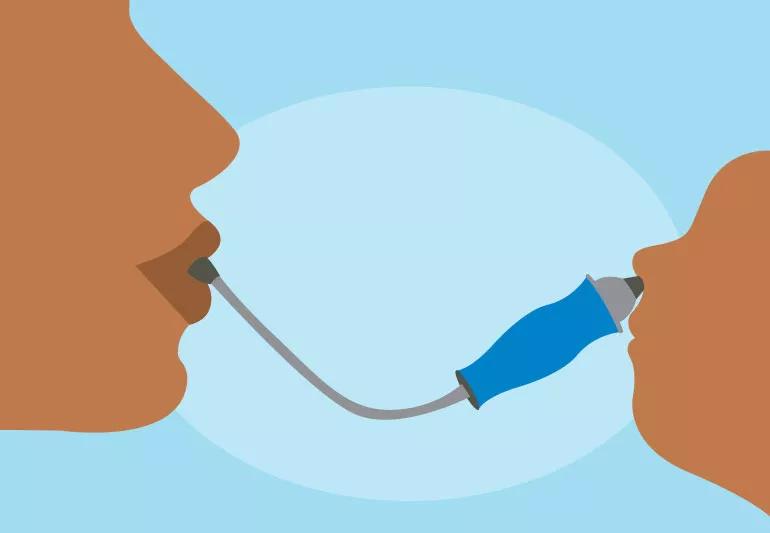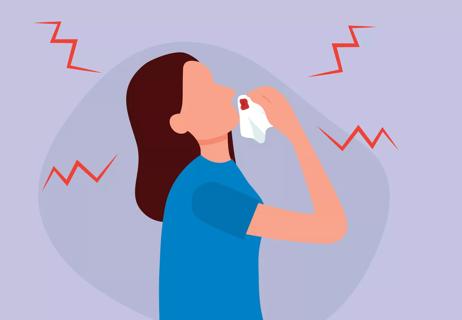Keeping your baby’s airways clear of mucus helps with breathing and feeding

When your baby gets congested, you just want to help them, especially because they can’t help themselves. A throat full of phlegm (mucus) can be especially troublesome for babies because they don’t yet know how to clear their throats with a good “Ahem!”
Advertisement
Cleveland Clinic is a non-profit academic medical center. Advertising on our site helps support our mission. We do not endorse non-Cleveland Clinic products or services. Policy
That’s where you come to the rescue with a baby nose sucker, otherwise known as a nasal aspirator. Pediatrician Noah Schwartz, MD, explains what causes phlegm in babies, the nasal aspirators available and how to use them.
Phlegm is kind of icky, but it does serve a purpose. In normal amounts, it keeps tissues from drying out and helps get rid of dust and other particles your baby inhales. But when there’s too much phlegm in their nasal passages, it can make it difficult for them to breathe, as babies almost exclusively breathe from their nose. The phlegm can also drain down into their throat (postnasal drip) interfering with their ability to eat and making breathing even more difficult.
Several things can trigger extra mucus production in your infant.
“We most often think of things like upper respiratory infections causing phlegm,” says Dr. Schwartz. But a cold isn’t the only cause of excess mucus.
Common causes of throat phlegm in babies include:
Advertisement
“In addition, babies just have really small nasal passages and nostrils,” explains Dr. Schwartz. So, it doesn’t take much for your baby’s nose to get stuffy.
Keeping your baby’s airways clear of mucus helps with breathing and feeding.
“But babies have a hard time clearing their nose and throat on their own,” says Dr. Schwartz. “They can’t clear their throats or blow their noses like toddlers can.”
You can provide relief from nasal congestion with a nasal aspirator. This device helps prevent mucus from getting into your baby’s throat. But once the mucus is already there, they have to cough it up.
“You may get concerned when your baby coughs,” says Dr. Schwartz. “But don’t stop them from coughing. It’s a reflex and the only way for them to clear throat phlegm. That’s one of the reasons we don’t recommend cough medicine for children younger than 5.”
If you’re concerned about your infant’s cough or breathing, you should make an appointment with their pediatrician.
Also known as a baby snot sucker, a nasal aspirator is a simple device for removing mucus from your baby’s nose. You can’t use a nasal aspirator in your baby’s mouth or throat. But clearing mucus from their nose keeps it from running down their throat.
There are a few types of nasal aspirators. Each has its own instructions.
Before reaching for a nasal aspirator, Dr. Schwartz advises using saline nasal drops or spray in your baby’s nose. The saline loosens the mucus, making it easier to get out. You can get saline nasal drops or spray in drugstores without a prescription. Be sure to get one that says it’s safe for infants and doesn’t contain any medication.
A suctioning bulb nasal aspirator is a rubber device with a round bulb and a tapered stem.
“This is the most common type of nasal aspirator,” says Dr. Schwartz. “New parents usually get one in the hospital to take home.”
Suctioning bulbs are inexpensive, readily available and can work well enough to give your baby relief. But they have a couple of drawbacks:
Advertisement
Oral suction nasal aspirators require you to use your mouth. You suck on the end of a tube to remove mucus from your baby’s nose.
“This makes some parents a little squeamish, but there is a filter between your mouth and your baby’s nose,” explains Dr. Schwartz. So, there’s no risk of ending up with a mouth full of baby boogers.
Ick factor aside, research shows that parents generally like oral nasal aspirators better than suction bulbs. Dr. Schwartz prefers oral suction nasal aspirators because they’re:
Electric suction nasal aspirators work the same way as oral suction nasal aspirators. The difference is that instead of using your mouth to create suction, you simply turn on the device.
Advertisement
“Electric nasal aspirators are the most expensive,” says Dr. Schwartz. “But they work well for parents who don’t want to use the oral suction type.”
“Unfortunately, there’s no magic trick to keeping your baby well and free of mucus all the time, and daycare can make this even more challenging,” says Dr. Schwartz.
In general, he recommends avoiding people who are sick if you can and washing your hands often. If you’re concerned that allergies or acid reflux might be causing throat phlegm in your baby, an appointment with your pediatrician is always the best course of action.
Advertisement
Learn more about our editorial process.
Advertisement

Staying calm, sitting up straight and gently pinching the sides of your nostrils can help a bloody nose go away faster

Dry air, allergies or nose-picking may be to blame for nighttime epistaxis

Take care of your runny or stuffy nose by staying hydrated, using a humidifier and considering a medication

Allergies, acid reflux and even pregnancy can increase drainage and upset your stomach

Yes, it’s safe for babies starting at about 9 months old and can help clear nasal mucus

Seek help if bleeding doesn’t stop or they’re interfering with your life

It’s usually the way your nose manages airflow, but sometimes, it could be other issues

Using a saline solution, they help relieve sinus pressure and remove excessive mucus

If you’re feeling short of breath, sleep can be tough — propping yourself up or sleeping on your side may help

If you fear the unknown or find yourself needing reassurance often, you may identify with this attachment style

If you’re looking to boost your gut health, it’s better to get fiber from whole foods